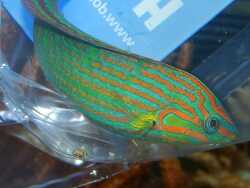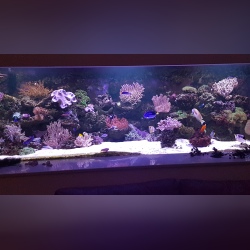Info
(Bleeker, 1851) Tail-spot wrasse
Found mostly on shallow coral reefs and rocky shores. Found over 15 m depth. Feed on small invertebrates such as polychaetes, copepods, isopods and forams.
Synonyms:
Halichoeres chrysotaenia (Bleeker, 1853)
Halichoeres hoeveni (Bleeker, 1851)
Halichoeres hoevenii (Bleeker, 1851)
Julis chrysotaenia Bleeker, 1853
Julis hoevenii Bleeker, 1851
Julis melanurus Bleeker, 1851
Platyglossus melanurus (Bleeker, 1851)
Classification: Biota > Animalia (Kingdom) > Chordata (Phylum) > Vertebrata (Subphylum) > Gnathostomata (Superclass) > Pisces (Superclass) > Actinopterygii (Class) > Perciformes (Order) > Labridae (Family) > Corinae (Subfamily) > Halichoeres (Genus)
Jumping guard
A jumping guard prevents (nocturnal) fish from jumping out.
Wrasses, blennies, hawkfishs and gobies jump out of an unprotected tank in fright if their night rest is disturbed, unfortunately these jumpers are found dried up in the morning on carpets, glass edges or later behind the tank.
https://www.korallenriff.de/en/article/1925_5_Jump_Protection_Solutions_for_Fish_in_the_Aquarium__5_Net_Covers.html
A small night light also helps, as it provides the fish with a means of orientation in the dark!
Found mostly on shallow coral reefs and rocky shores. Found over 15 m depth. Feed on small invertebrates such as polychaetes, copepods, isopods and forams.
Synonyms:
Halichoeres chrysotaenia (Bleeker, 1853)
Halichoeres hoeveni (Bleeker, 1851)
Halichoeres hoevenii (Bleeker, 1851)
Julis chrysotaenia Bleeker, 1853
Julis hoevenii Bleeker, 1851
Julis melanurus Bleeker, 1851
Platyglossus melanurus (Bleeker, 1851)
Classification: Biota > Animalia (Kingdom) > Chordata (Phylum) > Vertebrata (Subphylum) > Gnathostomata (Superclass) > Pisces (Superclass) > Actinopterygii (Class) > Perciformes (Order) > Labridae (Family) > Corinae (Subfamily) > Halichoeres (Genus)
Jumping guard
A jumping guard prevents (nocturnal) fish from jumping out.
Wrasses, blennies, hawkfishs and gobies jump out of an unprotected tank in fright if their night rest is disturbed, unfortunately these jumpers are found dried up in the morning on carpets, glass edges or later behind the tank.
https://www.korallenriff.de/en/article/1925_5_Jump_Protection_Solutions_for_Fish_in_the_Aquarium__5_Net_Covers.html
A small night light also helps, as it provides the fish with a means of orientation in the dark!







 Lemon Tea Yi Kai, Japan
Lemon Tea Yi Kai, Japan






































































































